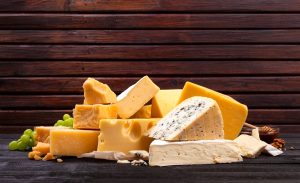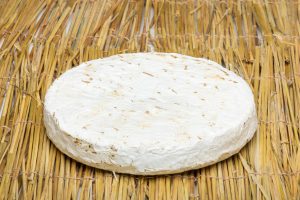Introduction to Cheese Making
3 Other Technological Criteria
The cheese families described above provide a useful ‘coat rack’ to help organize cheese according to the initial manufacturing procedures that determine cheese composition and its primary microstructure. The following is a more comprehensive summary of technological parameters that determine cheese characteristics. All of these parameters are addressed in later sections of this manual.
- Species
- Cow, goat, sheep, buffalo, yak, and other ruminants
- Milk standardization
- Fat and protein contents

Various types of cheese on black wooden table background. Cheddar, parmesan, emmental, blu cheese. - Whey and milk blends
- Fat and protein contents
- Coagulation
- Predominantly rennet gels
- Predominantly acid gels
- Heat-acid precipitates
- Moisture control
- Cooking temperature and time
- Mesophilic versus thermophilic cultures
- Amount and acidifying properties of the culture
- Curd ripening
- Heat treatment of the milk

An example of a rindless cheese that is film wrapped.
- Type of pH control
- Direct acidification versus fermentation
- Amount and type of culture
- Lactose removal:
- Washing (American, Dutch)
- High temperature syneresis (Swiss, Hard Italian)
- High acid syneresis (Feta, Cheshire)
- Curd ripening (Cheddar, low moisture Pasta Filata)
- Extent of acid development
%3Amax_bytes(150000)%3Astrip_icc()%2FGruyere1500-56a125ae3df78cf77267d404.jpg&f=1&nofb=1)
An example of a dry rind cheese. - Low acid (minimum pH > 5.8), Latin American fresh cheese
- Medium acid (minimum pH 5.0 – 5.5), most European varieties
- High acid (minimum pH < 4.9), fresh cheese, soft ripened cheese
- Salting procedures
- Vat salting before forming
- Surface salting after forming
- Immersion in salt brine
- Type and duration of ripening
- Fresh versus ripened
- Interior ripening, including blue veined cheese
- Interior and surface ripened
- Bacterial / yeast smears
- White surface mold
- Mixed rinds
- Type of rind
- Rindless – waxed, film wrapped, resins
- Dry rind (cured at 85% relative humidity)

An example of a surface ripened cheese. - Surface ripened (cured at 90 – 95% relative humidity)
- Texture and body
- Openings: mechanical, small holes, large holes
- Firmness
- Melting properties
- No melt: softening without flow (frying cheese)
- Stretching: Low melt and stretchable (Mozzarella)
- Fondue: Medium melt, medium strechability (Raclette)
- High melt: flows readily with little stretchability (aged Cheddar)
Table 3.1: Some properties of cheese categorized according to type of coagulation, and procedures for moisture and acidity control. Plus signs in column three indicate relative amounts
| Varieties | Coagulation | Moisture in non-fat substance | pH at 4-7 days | Ca mM/Kg SNF | Curing Time | |
| Acid Coagulated | Cottage, Quark, Cream Cheese, Chaource, Figaro | Acid coagulation at pH 4.6-4.8 | 72-80%, aw 0.980-0.995. Controlled by cooking and washing treatments | 4.3-4.8; Inhibition of culture by low pH, high temperature cooking or cooling, and/or washing | 50-350 | Consumed fresh, short shelf life |
| Heat-acid Coagulated | Indian Paneer and Channa, Ricotta, Requeson. Useful as cooking cheese | Heat denatured whey proteins are co-precipitated with caseins by acid. Whey proteins inhibit melting | 75-84%. Increases with whey protein content, decreases with cooking after acidification | 5.0-5.8; Due to the amount of acidulant added. 3-6% lactose in cheese due to absence of fermentation | Normally consumed fresh, limited shelf life unless hot packed, pickled, or packed in sugar syrup | |
| Unripened: Rennet Coagulated | Some Latin American, Middle Eastern, and European varieties. Useful as cooking cheese | Rennet++, Little or no culture, cutting near endogenous pH | 60-80%, Controlled by cooking, stirring out, and draining conditions. Syneresis often occurs in the package | 5.8-6.6; Little or no culture -High pH prevents melting |
Consumed fresh, high pH limits shelf life | |
| Soft Ripened: High Acid | Feta. Camembert, Blue | Rennet+++, Culture+++, Ripening time+++, cutting at pH <6.5 | 60-70%, aw 0.96-0.99. Syneresis induced by acid development and by salting | 4.5-4.8; Controlled by acid inhibition of culture, salting, and cooling. | 400-600 | 2 - 8 weeks |
| Semi-hard Cheese: Washed | Gouda, Edam, Colby, Havarti, Montasio, and many others | Rennet++, Culture+, Ripening time++, Cutting at pH <6.6 | 55-65%, aw 0.95-0.97. Controlled by cooking, temperature of wash water, rate of acid development, curd handling, salting treatments | 5.0-5.2; Controlled by washing to remove lactose and other treatments such as cooking, culture selection, and salting. | 500-700 | 2 weeks - 9 months |
| Hard Cheese: Low Temperature | Cheddar, Provolone | Rennet++, Culture++, Ripening time++, Cutting at pH<6.6 | 52-60%, aw 0.94-0.96. Controlled by cooking, curd handling, rate of acid development, and salting | Rate of acid development and moisture control determines residual lactose; draining pH is critical | 500-700 | 1 - 24+ months |
| Hard Cheese: High Temperature | Swiss types, Italian types (such as Parmesan) | Rennet+, Culture+, Ripening+ (little or none for Swiss), Cutting at pH near 6.6 | 39-52%. Controlled mainly by high temperature cooking (52-55ºC) | Acidity and moisture determine residual lactose; draining pH is critical | 600-800 | 1 - 24+ months |
Adapted from Hill (2007)
Table 3.2: Typical composition (% by weight) of some cheese varieties.
| Type | Cheese | Moisture % | Protein % | Fat | Total CHO | FDM | Ash | Ca | P | Salt | Retail pH |
| Acid Coagulated | Cottage Creamed cottage Quark Cream Neufchatel |
79.8 79.0 72.0 52.7 62.2 |
17.3 12.5 18.0 7.5 10.0 |
0.42 4.5 8.0 34.9 23.4 |
1.8 2.7 3.0 2.7 2.9 |
2.1 21.4 28.5 75.4 62.0 |
0.7 1.4 1.2 |
0.03 0.06 0.30 0.08 0.07 |
0.10 0.13 0.35 0.10 0.13 |
nil 1.0 0.73 |
5.0 5.0 4.5 4.6 4.6 |
| Heat-Acid Coagulated | Chhana Frying cheese Ricotta-3% fat milk Ricotone - from whey & milk |
53.0 55.0 72.2 82.5 |
17.0 19.7 11.2 11.3 |
25.0 20.4 12.7 0.5 |
2.0 3.0 3.0 1.5 |
53.2 44.8 45.7 2.9 |
3.0 <0.5 <0.5 |
5.4 5.9 5.8 |
|||
| Fresh Rennet Coagulated | Queso Blanco Queso de Freir Italian fresh cheese |
52.0 52.4 49.0 |
23.0 23.0 28.0 |
20.0 19.5 16.0 |
42.0 41.0 31.4 |
2.5 3.0 nil |
5.8 5.8 6.5 |
||||
| Soft Ripened | Camembert Feta Blue Gorgonzola |
51.8 55.2 42.0 36.0 |
19.8 14.2 21.0 26.0 |
24.3 21.3 29.0 32.0 |
0.5
2.3 |
50.3 47.5 50.0 50.0 |
3.7 5.2 5.1 5.0 |
0.39 0.49 0.53 |
0.35 0.34 0.39 |
2.1
3.5 |
6.9 4.4 6.5 |
| Semi-hard Washed | Colby Gouda Edam Fontina Havarti-Danish Munster |
40.0 41.5 41.4 42.8 43.5 41.8 |
25.0 25.0 25.0 24.2 24.7 23.4 |
31.0 27.4 27.8 25.5 26.5 30.0 |
2.0 2.2 1.4 1.1 |
51.7 46.9 47.6 44.6 46.9 51.6 |
3.4 3.9 4.2 3.3 2.8 3.7 |
0.68 0.70 0.73 0.72 |
0.46 0.55 0.54 0.47 |
0.65 0.82 0.96 1.2 2.2 1.8 |
5.3 5.8 5.7 5.6 5.9 6.2 |
| Hard Cheese Low-Temp. | Cheddar Manchego-Spain Provolone Mozzarella |
36.7 37.9 40.9 54.1 |
24.9 28.1 25.6 19.4 |
33.1 26.9 26.6 21.6 |
1.3
2.1 |
52.4 45.2 45.1 47.1 |
3.9 3.6 4.7 2.6 |
0.72
0.76 |
0.51
0.50 |
1.8 1.5 2.2 1.0 |
5.5 5.8 5.4 5.3 |
| Hard Cheese High-Temp. | Parmesan Romano Swiss Kefalotyri |
29.3 30.9 37.2 34.2 |
35.7 31.8 28.4 24.8 |
25.8 26.9 27.4 28.3 |
3.2 3.6 3.4 |
36.5 39.0 43.7 |
6.0 6.7 3.5 4.7 |
1.18 1.06 0.96 |
0.69 0.76 0.60 |
3.0 3.0 1.2 |
5.4 5.4 5.6 5.2 |
Adapted from Hill (2007)

